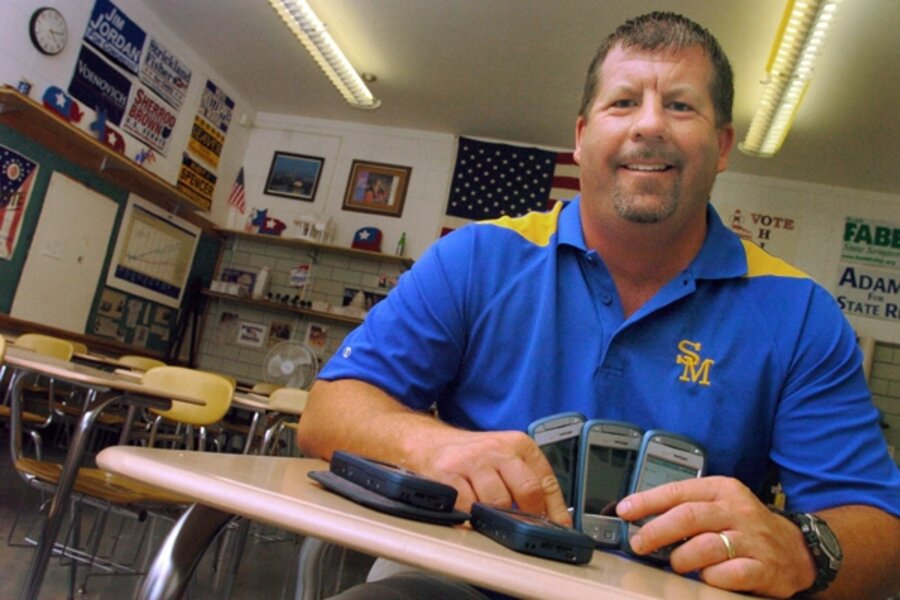Schools add cellphones to curriculum – slowly
Loading...
| NEW YORK
Smart phones now have hundreds of applications meant to educate kids — from graphic calculators to animation programs that teach spelling and phonics.
And while most public schools don’t allow the devices because they’re considered distractions — and sometimes portable cheating tools — some school districts have started to put the technology to use.
The key, educators say, is controlling the environment in which they are used.
In St. Mary’s, Ohio, a school district of 2,300 students is continuing a pilot program where third-, fourth- and fifth-graders are assigned PDAs for use as a learning tool in the classroom, and at home. They use applications created by a company called Go Know! to draw pictures and create sketches, journal and write essays, said Kyle Menchhofer, the district’s technology coordinator. Other applications create flash cards for spelling and math.
Students took the phones on a museum field trip where they took photos, uploaded them to a server where the teacher could view the assignment and wrote blurbs about what they saw.
In addition to the applications that students use, having the PDA teaches them responsibility, he said.
“Cell phones aren’t going away. Mobile technology isn’t going away,” he said. “Right now, what we’re telling kids is ’You go home and use whatever technology you want, but when you get to school, we’re going to ask you to step back in time.’ It doesn’t make any sense,” he said.
The district started the program last school year with $40,000 and 60 Palm personal data devices that were handed out to students. Menchhofer said teachers who used to wait weeks to use computer labs were now able to use technology right in their classrooms — and students love it.
But there are many questions districts face before opening the door to allow cell phones: If children had their own, fancier phones, would they be allowed those instead of school-issued devices? How would they fund PDAs in larger districts?
And do kids really need technology always at their fingertips?
Orlando, Fla., dad Ken Schneider says he doesn’t want his two daughters, ages 12 and 19, to be distracted in class by buzzing phones or text messages. Still, he says a limited, school-sponsored version is a good idea.
“A very controlled form of communication would be great,” he said. “To the extent you can build computer literacy at the youngest age, it’s great. That’s where the world is moving.”
In St. Mary’s, parents and district officials decided to expand the program for the upcoming school year. Text and cell phone applications are shut off, so the data plan will cost about $17 a month per phone. The phones are free because of government pricing, but students will have to foot the bill if they’re lost or broken.
It’s worth it, Menchhofer argues. “We need to teach them to be responsible users of cell phones,” he said.
“There’s a right time and a wrong time to use them.”
Elliot Soloway, the creator of Go Know!, which developed the software, said trying to sell it was a slog for years because of the cell phone ban in most schools. But he said he thinks it’s about to change because he’s been getting increasing requests.
“Kids want to use the same tools inside school they use when they walk out the door,” he said. “Kids don’t worry about small screen sizes or typing trouble. Kids today are the mobile generation and it’s time we embraced this as a way to better educate our students.”
But the purported educational value of the cell phones doesn’t seem to sway most school districts, including New York, the largest in the country with a million students. Mayor Michael Bloomberg, who is in charge of the schools, emphasized his opposition in a recent speech to National Urban League executives, who exploded into applause.
“You come to school to learn, he declared, “not to play games or send text messages.”
Parents are eager for their kids to have every educational tool available but have mixed feelings about whether cell phones are useful in the classroom.
But parent John Leaf in Milwaukee wondered about the disadvantages for kids whose parents can’t afford cell phones for them outside of school.
“If my kids have good cell phones and it helps them perform academically, that’s great. But what about the kids who don’t have cell phones ore the latest applications?”
His daughter, Erin, 14, is going to be a freshman at Homestead High School outside Milwaukee. She uses her phone in designated areas at school for practical reasons, to call her mom or to schedule rides. She likes the idea of using PDAs in class, but doesn’t think it’s necessary.
“Anything that helps to better educate me I’d use,” she said. “But cell phones are such a distraction from school. I never use it in class now because I’m too busy paying attention.”





